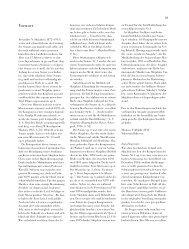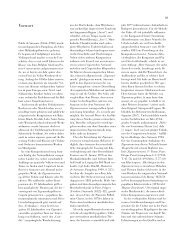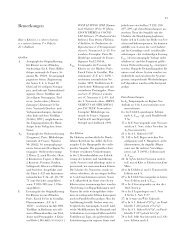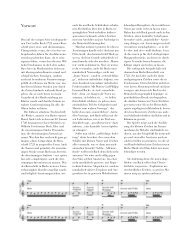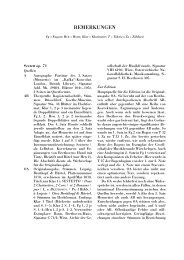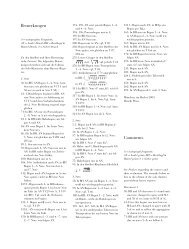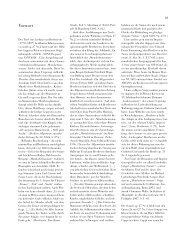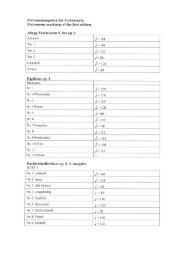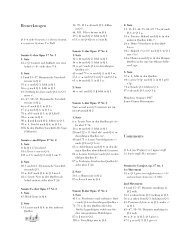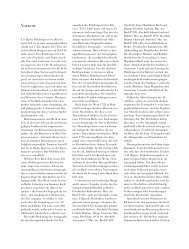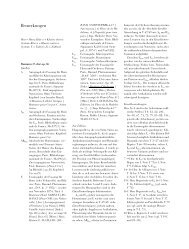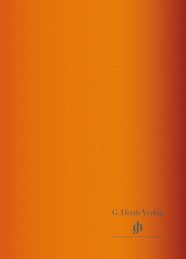Vorwort (PDF, 360 KB) - Henle Verlag
Vorwort (PDF, 360 KB) - Henle Verlag
Vorwort (PDF, 360 KB) - Henle Verlag
You also want an ePaper? Increase the reach of your titles
YUMPU automatically turns print PDFs into web optimized ePapers that Google loves.
VI<br />
genten Kopisten transponieren zu lassen“<br />
(Postkarte an Hans Heinsheimer,<br />
Universal Edition, Eingang 16. August<br />
1935, Wienbibliothek, Nr. 422).<br />
Noch bevor sich Berg und Krasner am<br />
16. September zu dem Durchgang der<br />
Komposition trafen, hatte Rita Kurzmann<br />
(1900–42) mit der Anfertigung<br />
des Klavierauszugs begonnen. Sie wirkte<br />
während Krasners Europa-Aufenthalt<br />
nicht nur als dessen Korrepetitorin, sondern<br />
stellte darüber hinaus die entscheidenden<br />
Kontakte zu den Komponisten<br />
der Zweiten Wiener Schule her, aus<br />
denen schließlich auch der Auftrag für<br />
das Violinkonzert erwuchs. Als Vorlage<br />
diente ihr zunächst die autographe Partitur;<br />
als diese dann für die Herstellung<br />
der Orchesterstimmen an den <strong>Verlag</strong><br />
ging, erhielt sie von Berg das Particell.<br />
Fragliche Stellen wurden zwischen Berg<br />
und Rita Kurzmann bei einer Zusammenkunft<br />
am 5./6. Oktober besprochen.<br />
Am weiteren Herstellungsprozess (sowohl<br />
der Stimmen als auch der Druckausgabe)<br />
hatte Berg keinen Anteil mehr.<br />
Er starb in der Nacht zum 24. Dezember<br />
1935 an den Folgen einer Blutvergiftung.<br />
Die Uraufführung des Violinkonzerts<br />
fand am 19. April 1936 im Rahmen des<br />
14. Musikfestes der Internationalen Gesellschaft<br />
für Neue Musik (IGNM) in<br />
Barcelona statt, bei der Hermann Scherchen<br />
für den kurzfristig psychisch indisponierten<br />
Anton Webern die Leitung<br />
übernahm. Am eindringlichsten hielt<br />
vermutlich Erich Steinhard in seiner Rezension<br />
den unmittelbaren Eindruck<br />
fest, den das Werk ausübte: „Die Bläser<br />
respondieren und nun setzen wunderbare<br />
Choralvariationen ein, die nach<br />
mächtiger Gradation zu einem himmlisch<br />
zarten Ausklang hinüberleiten, zu<br />
einem Abschiednehmen ohne Ende. Das<br />
Publikum ist gebannt. Hermann Scherchen,<br />
der meisterliche Dirigent, nimmt<br />
die handgeschriebene Partitur Alban<br />
Bergs vom Pult und hält sie der ergriffenen<br />
Zuhörerschaft wie ein Meßbuch<br />
entgegen“ (Der Auftakt 16, 1936, Juniheft,<br />
S. 90). Schon am 16. September<br />
1935 hatte Alban Berg gegenüber seinem<br />
Jugendfreund Hermann Watznauer<br />
(1875–1939) bemerkt: „Wir bleiben<br />
halt unverbesserliche Romantiker! Auch<br />
mein neues Violinkonzert bestätigt es<br />
wieder“ (zitiert nach Stephan, S. 40).<br />
Herausgeber und <strong>Verlag</strong> danken den in<br />
den Bemerkungen genannten Bibliotheken<br />
für die Bereitstellung von Quellenkopien.<br />
Ammerbuch, Frühjahr 2009<br />
Michael Kube<br />
Preface<br />
Following a period of experimentation,<br />
at the beginning of the 1930s the instrumental<br />
concerto experienced a new<br />
flowering as part of a general stylistic<br />
consolidation. Many of the violin concertos<br />
from that time are regarded today<br />
as “classics of modernity,” including<br />
those of Igor Stravinsky (1931), Alban<br />
Berg (1935), Arnold Schönberg (1936),<br />
Serge Prokofiev (1937) and Béla Bartók<br />
(1938), Samuel Barber (1938/39), Benjamin<br />
Britten (1938/39), William Walton<br />
(1938/39), Paul Hindemith (1939),<br />
and Karl Amadeus Hartmann (1939).<br />
Alban Berg’s Violin Concerto occupies,<br />
without question, a special place within<br />
this impressive list of works, since within<br />
it – and this is a quality that otherwise<br />
is found in only a few compositions<br />
in the history of western music – extramusical,<br />
symbolic and autobiographical<br />
elements are combined in a unique way<br />
to produce a score that stands alone in<br />
respect of its form and its material.<br />
The impetus for the composition<br />
came from the American violinist Louis<br />
Krasner (1903–95), who approached<br />
Berg in February 1935 with a request<br />
for a violin concerto. On 1 March and<br />
26 April the two men met to draw up a<br />
contract for work on a concerto of 20<br />
minutes’ duration, for which an honorarium<br />
of $1,500 would be paid if the<br />
work was supplied by 31 October (the<br />
contract is in the publisher’s archive of<br />
Universal Edition in Vienna). Without a<br />
doubt, financial necessity led Berg to accept<br />
this lucrative commission, in spite<br />
of the extremely short deadline. This did<br />
not suit his usual drawn-out way of<br />
composing, but was the result of Krasner’s<br />
stay of several months in Europe<br />
(he was residing in Vevey, in Switzerland).<br />
That Berg worked very seriously on<br />
the composition from the outset is revealed<br />
in a letter to Krasner of 28 March<br />
1935, which reflects on the historical<br />
dimension of the commission: “I am<br />
happy to hear that you are staying in<br />
Europe over the summer, and want to<br />
work. Since in May I shall compose ‘our’<br />
violin concerto (for which I have already<br />
done much prepatory work) at the<br />
Wörther-See (diagonally opposite Pörtschach,<br />
where Brahms composed his violin<br />
concerto), we can perhaps also stay<br />
in contact during composition of this<br />
work” (Musikblätter des Anbruch 18,<br />
1936, p. 196). This preparatory work<br />
must have included not only a study of<br />
the scores of relevant violin concertos<br />
such as those by Lalo, Szymanowski<br />
and Glazunov, as is evident from some<br />
manuscript notes in the sketches), but<br />
also a first sketch of the formal layout in<br />
which are laid out not only the course of<br />
the work, but also many details that<br />
were changed later: the two-movement<br />
form of the concerto, and the division of<br />
each of these movements into two parts,<br />
the basic character of these parts (Frei,<br />
Fröhlich, Fromm, Frisch), their musical<br />
conception – phantasierend for the projected<br />
first section of the first movement,<br />
and (Rondo) for the planned second<br />
section of the second movement –,<br />
their tempo and dynamics, along with<br />
the inclusion of quotations or pre-existing<br />
music, namely the (verträumte)<br />
Ländlerweise Jodler (dreamy, Ländlerlike<br />
yodelling-song) and (Choral) (Vienna,<br />
Österreichische Nationalbibliothek,<br />
Musiksammlung, shelfmark F 21 Berg<br />
432/15, pp. 161 f.). The sketches also<br />
reveal that, at his first attempt, Berg derived<br />
the basic twelve-tone row of the<br />
concerto from the tuning of the strings<br />
of the violin, and used thirds to expand



